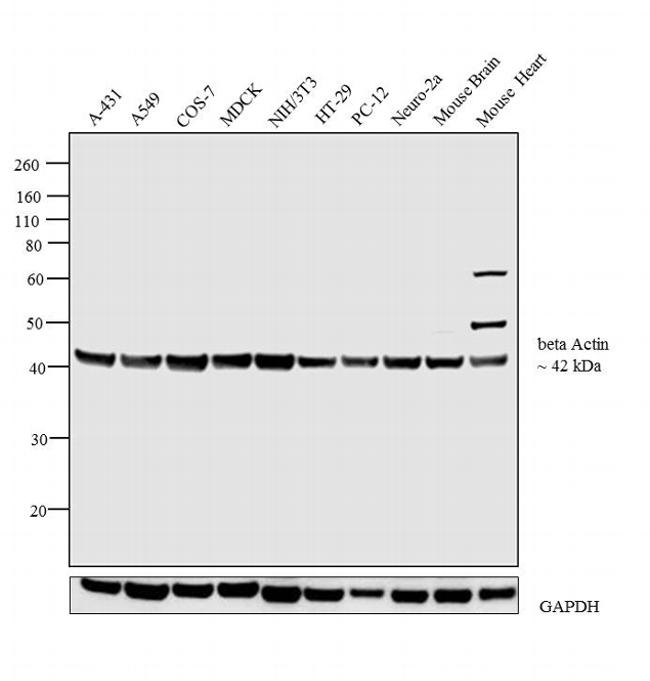

In contrast, β-tubulin, whose expression was not significantly affected by SCI, is a better choice for the internal control. Anti-Actin is a loading control antibody and is critical for the correct interpretation of your western blot. 0.2 m filtered solution in PBS Conjugate. Taken together, our study suggests that β-actin whose expression increases following SCI is not a suitable internal control for Western blot analysis of spinal cord tissues following a traumatic injury. actin belongs to a class of genes called housekeeping genes. beta-Actin Loading Control Antibody, Mouse MAb General Information Purification. They are used as a control as they remain stable in the presence of a wide range of compounds. Beta-actin is approximately 42 kDa and GADPH is approximately 36 kDa.

The CV of β-tubulin expression following SCI was 14.3 β 3.96%, significantly less than that of the β-actin expression (43.79 ± 4.67% p < 0.01). Beta-actin is commonly used as a western blot loading control as is expressed within all eukaryotic cell types and is not affected by cellular treatments.

They seem like they should be good controls, but there are some major reasons why housekeeping genes can give you trouble. In contrast, no statistically significant difference was found in β- tubulin expression following SCI, compared with sham-operated controls. Common housekeeping genes used to normalize Western blots include: glyceraldehyde 3-phosphate dehydrogenase (GADPH), beta-actin, tubulin or heat shock protein 90 (HSP90). Coefficient of variation (CV) analysis showed that the CV of β-actin expression was 43.79 ± 4.67%, significantly higher than that of six loadings from a single sample (6.5 ± 0.9%, p < 0.01), indicating that increased expression of β-actin was a result of SCI, instead of a loading error. Beta actin is often used in Western blotting as a loading control, to normalize total protein amounts and check for eventual protein degradation in the samples. Using Western blot analysis, we demonstrated that spinal cord injury (SCI) induced a significant increase in β-actin expression which peaked at 7 days post-SCI (2.48-fold). If so, their use as an internal control may have a negative impact on data acquisition, analysis, and interpretation. However, no information is available concerning the stability of their expressions in response to a traumatic injury to the central nervous system (CNS). To date, two housekeeping gene–coded proteins (i.e., β-actin and β-tubulin) are widely used as internal controls in the Western blot analysis.
-Western-Blot-NBP2-76367-img0003.jpg)
To control and correct for loading error, an internal control is often used. Nevertheless, the exact role of THSG in pulmonary fibrosis has not been demonstrated yet. (PMT), which has been reported to possess extensive pharmacological properties. Western blot is a widely used method for determining specific protein levels. 2,3,5,4-Tetrahydroxystilbene-2-O-D-Glucoside (THSG) is the main active ingredient extracted from Polygonum multiflorum Thunb. Western Blot Positive Control Actin, cytoplasmic 1 AntibodyĪctins are highly conserved proteins that are involved in various types of cell motility and are ubiquitously expressed in all eukaryotic cells.ĪTP binding, Identical protein binding, Kinesin binding, nitric-oxide synthase binding, structural constituent of cytoskeleton, Tat protein bindingĪctin, cytoplasmic 1, N-terminally processed antibody


 0 kommentar(er)
0 kommentar(er)
